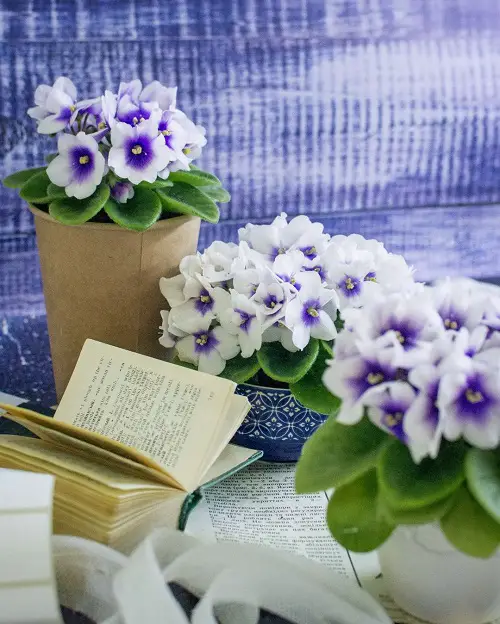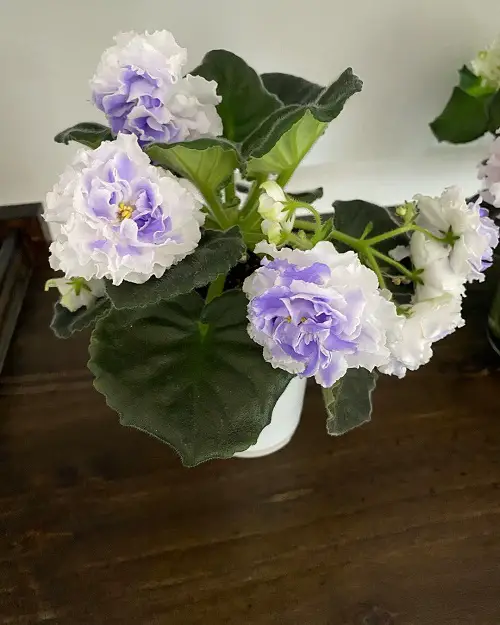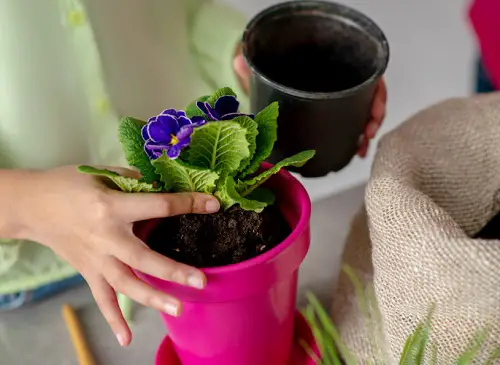If you’re wondering How to Force African Violets to Bloom, start by evaluating their care routine. Here’s how along with top tips!
Take action now to transform your African violets into an attractive display of flowers. Check the lighting conditions and consider relocating your plants to a spot that receives gentle, filtered light. Keep reading for more information!
How to Force African Violets to Bloom
1. Watering Tips
Watering is critical when your plant is about to bloom.
So as to keep the soil properly hydrated, check the soil moisture by feeling the top inch of the soil with your fingers. If it feels dry, it’s time to water your plant. Alternatively, a moisture meter can be used for more precise measurements.
Follow this way to water to avoid lapse:
- Directly water to the soil only, avoiding the leaves to prevent potential rot.
- Try bottom watering. Place the pot in a shallow tray filled with water and let the plant drink from the bottom up. This promotes even soil moisture.
- Also, you can occasionally switch to top watering to cleanse the soil of accumulated salts.
Always allow for adequate drainage after watering. Let the plant stand for an hour to let excess water drip away, which helps avoid the dangers of root rot.
Tip: Use water that’s at room temperature to avoid shocking your African violets. The goal is to saturate the soil to the consistency of a damp sponge—moist yet free of excess water.
2. They Need a lot of Light!

African violets thrive under bright, indirect sunlight. Right! You must be aware of that. So, the optimal placement is near windows that face north or east. This positioning shields them from the harsh direct sunlight that can damage their leaves.
Also, if natural light in your space is too strong, consider using sheer curtains to diffuse it effectively, ensuring it remains gentle yet ample for the plants’ needs.
However, not all indoor environments can provide natural light suitable for African violets. Right! In such cases, artificial lighting becomes essential. Fluorescent grow lights or LED options are excellent alternatives. You can position these lights approximately 12 to 15 inches above the plants.
A Green Thump Tip: If the leaves turn a lighter shade of green, it might indicate excess light exposure. Conversely, if the leaves appear unusually thin and dark or if the plant stretches out (becomes leggy). It’s a sign of inadequate light. Both scenarios can hinder the plant’s ability to flower.
Look here to learn about growing African Violets indoors
3. Give them Plenty of Humidity
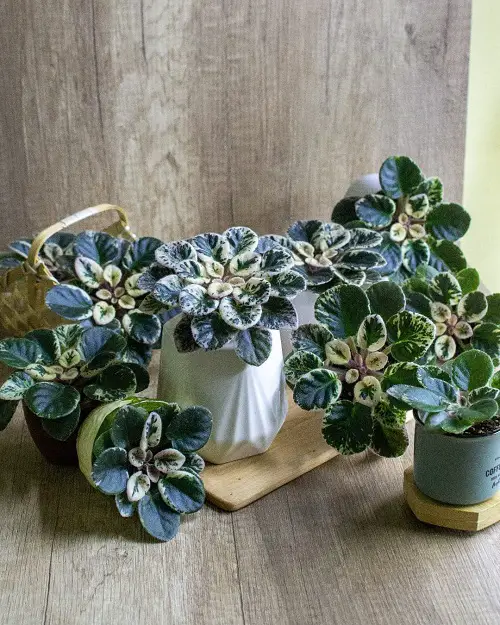
African violets are known for their preference for humid environments and can face challenges in dry climates or indoor conditions, especially during the colder months.
So, to make these plants thrive and bloom to their full potential, you must provide them with sufficient humidity. If you are unable to do that, place a humidifier in your room near African violets to boost the humidity levels. This will help maintain an ideal environment for the plants to flourish.
Another way is to use a pebble tray. Here’s how to set it up: Fill a shallow tray with small pebbles. Then, add water to the tray until it is just below the top of the pebbles. Now, place the plant pot on the pebbles, ensuring the bottom does not touch the water.
A Tip: Lightly misting the leaves of your African violets can also help increase the humidity. Remember to mist lightly to avoid waterlogging the soil or causing leaf spots.
Look at the ways to increase humidity for houseplants
4. African Violets Like to be Root-Bound
When African violets are slightly root-bound, their roots fill up the pot just enough to send a signal that space is limited. This condition encourages the plant to shift its focus from growing roots to reproducing through flowers. In this way, the compact roots tell the plant it’s time to bloom, leading to a more prolific flowering phase.
However, the slightly root-bound conditions can be beneficial. It’s vital to avoid letting the African violet become too constrained. An overly tight root system can lead to several issues, such as root suffocation and poor water and nutrient absorption.
It can stress the plant and diminish its health and blooming capability. So, to maintain health and flowering, you must monitor it wisely and repot before the roots are overly compressed.
5. Fertilize Right
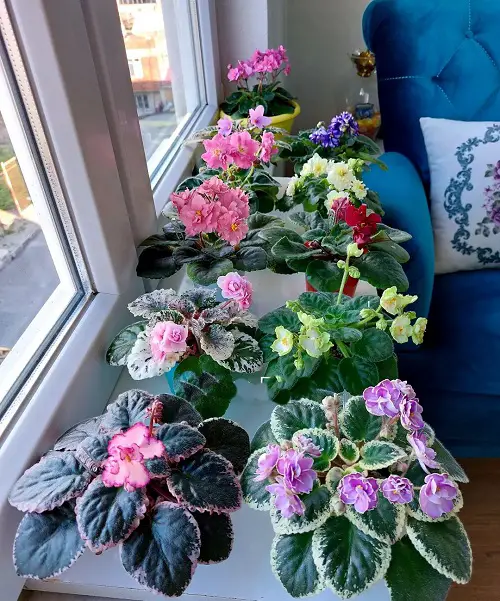
To encourage vibrant growth and blooming in African violets, apply a specialized African violet fertilizer bi-weekly during their active growing seasons, which are spring and summer.
While keeping in mind the dosage recommendations provided on the fertilizer’s packaging to avoid overfeeding, which can be detrimental to the plant’s health.
Additionally, as the colder months approach and your African violets enter a slower growth phase, it’s advisable to reduce fertilization.
A tailored Blomming Tip: Invest in incorporating a bloom-boosting fertilizer for your African Violets. These products are designed with a higher phosphorus content, which is essential for flower development.
6. Keep them Warm
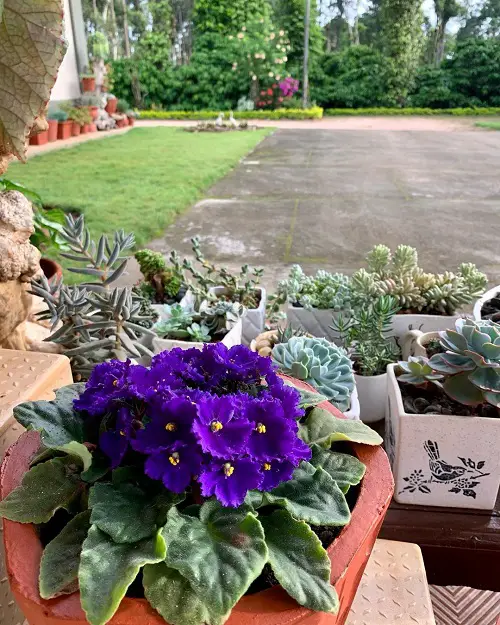
For optimal blooming, African violets require a consistent temperature of around 70°F. To prevent any negative impact on their health and blooming potential, check that the temperature does not dip below 60°F. Okay!
Additionally, it’s crucial to protect these plants from any sudden temperature changes, which can cause stress and affect their blooming cycle.
When positioning your African violets within your home, check their placement in relation to windows, especially during colder months.
You must avoid placing your plants near drafty windows, as the colder air can significantly cool the immediate area, potentially harming your African violets.
7. Removing Suckers
By removing suckers from African violets, you are helping the plant to focus its resources on producing flowers instead of supporting unnecessary growth. So that the energy is preserved to create vibrant blooms.
This can also prevent plants from becoming too dense, which often leads to decreased air circulation and reduced light reaching the inner parts of the plant. Better airflow and light exposure can decrease the risk of fungal infections and enhance photosynthesis, which is vital for healthy flowering.
How you can remove suckers on African violets :
- Wait until the suckers are big enough to have established their own roots before trimming. This makes them more likely to survive if you plan to replant them elsewhere.
- Always use clean and sharp scissors or shears to reduce the risk of spreading diseases between plants and ensure a clean cut that will heal more quickly, minimizing stress to the plant.
- Aim to make your cut as close to the main plant’s base as possible without injuring the primary stem or roots.
- Clean cuts help prevent issues with pests and diseases, keeping your plant healthy.
- Avoid over-pruning as it can stress your African violet, potentially reducing its overall health and flowering capability.
8. Check for Pests or Diseases

The common pests that target these plants are aphids, which often attack new growth, distorting and yellowing leaves, which impacts the plant’s overall vitality and bloom potential.
Mealybugs gather in hidden spots, such as leaf joints and plant bases, draining the plant’s resources and weakening its flowering ability.
Similarly, spider mites feed on plant sap and cause the leaves to develop a stippled appearance, leading to general weakness. Thrips inflict surface damage that leads to distorted and discolored leaves, further reducing the plant’s aesthetic value and blooming capacity.
So, you must take the lead and regularly expect to catch infestations early. Isolating affected plants prevents pests from spreading.
Depending on the severity of the infestation, treatments might range from organic solutions like neem oil to more potent chemical insecticides.


